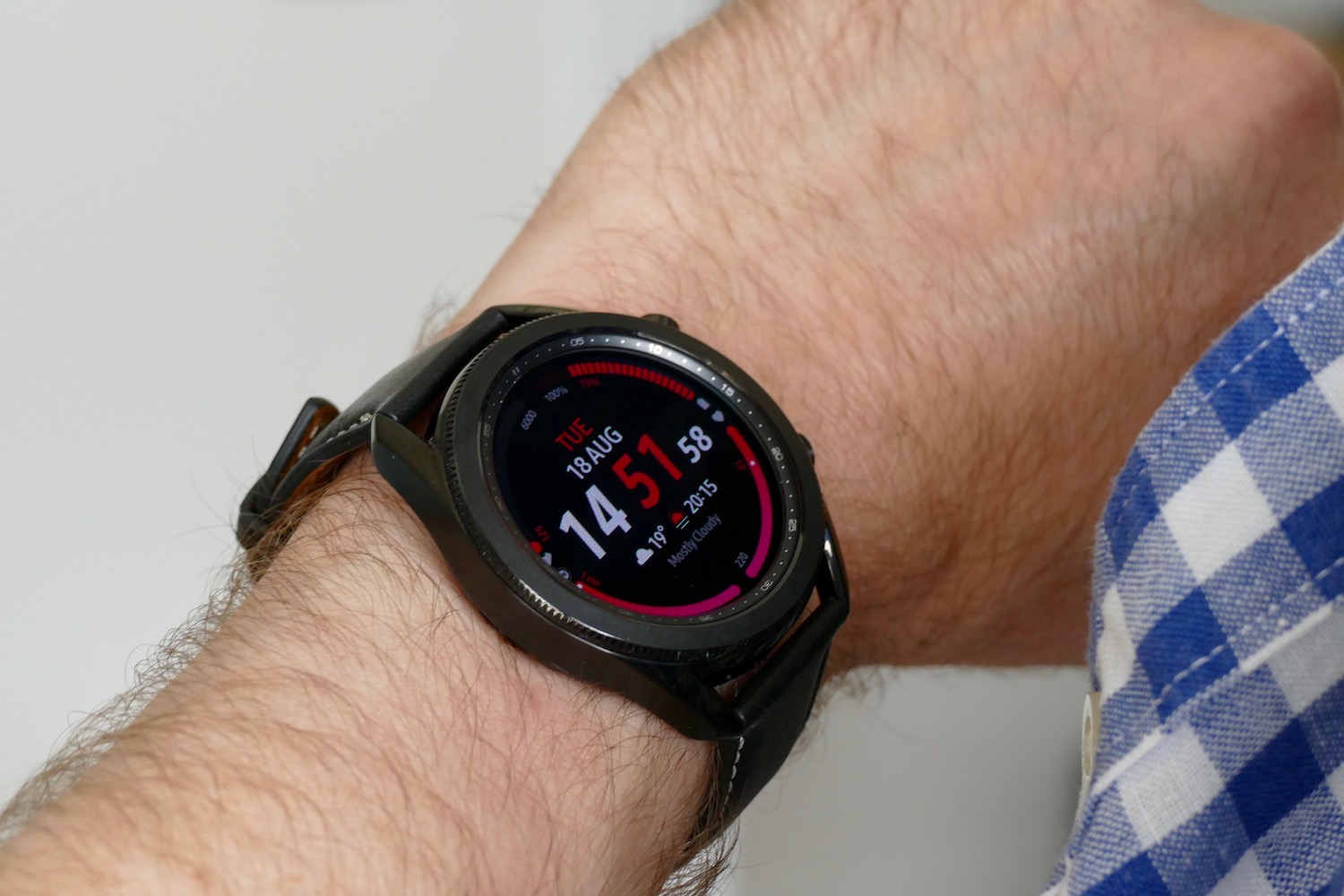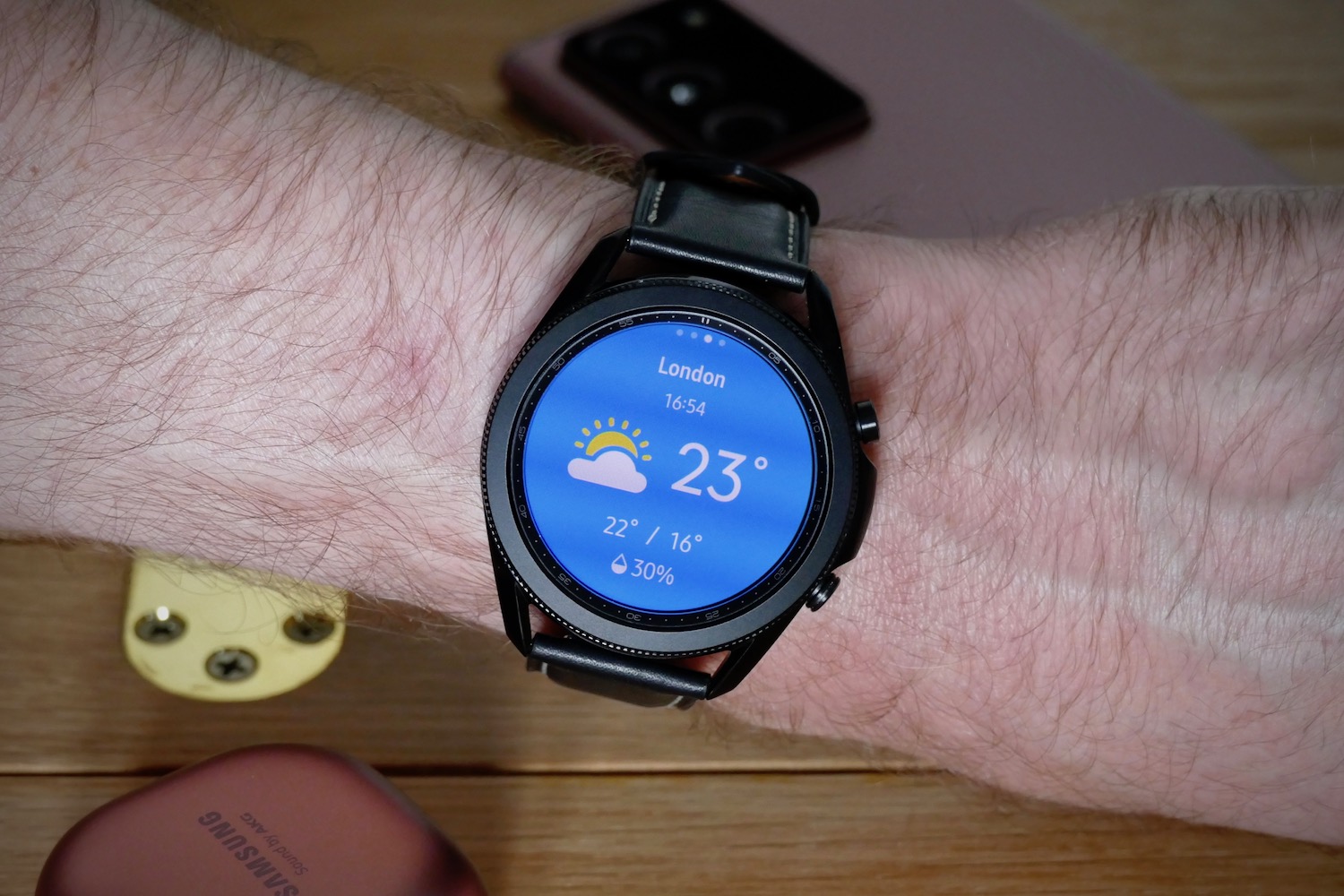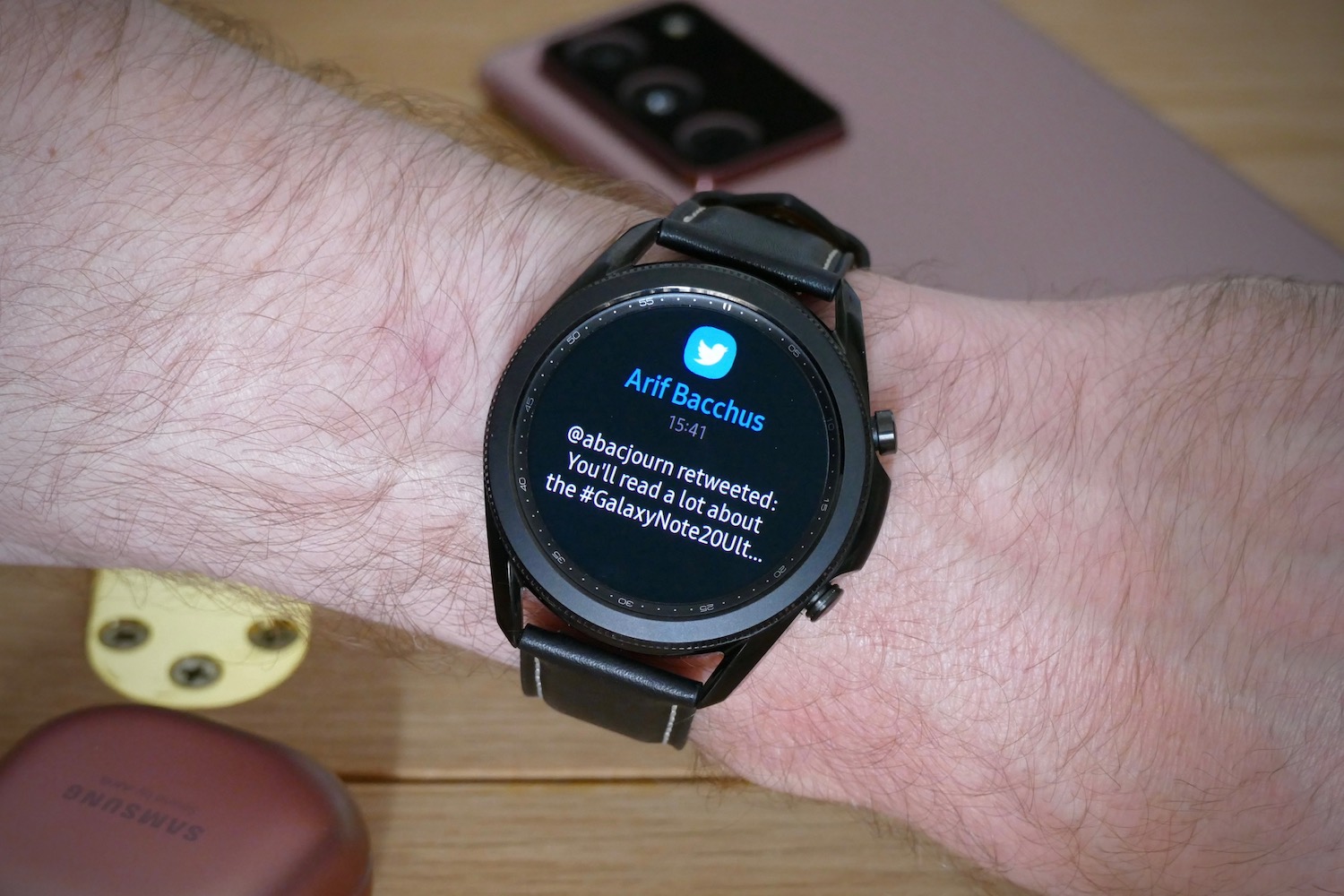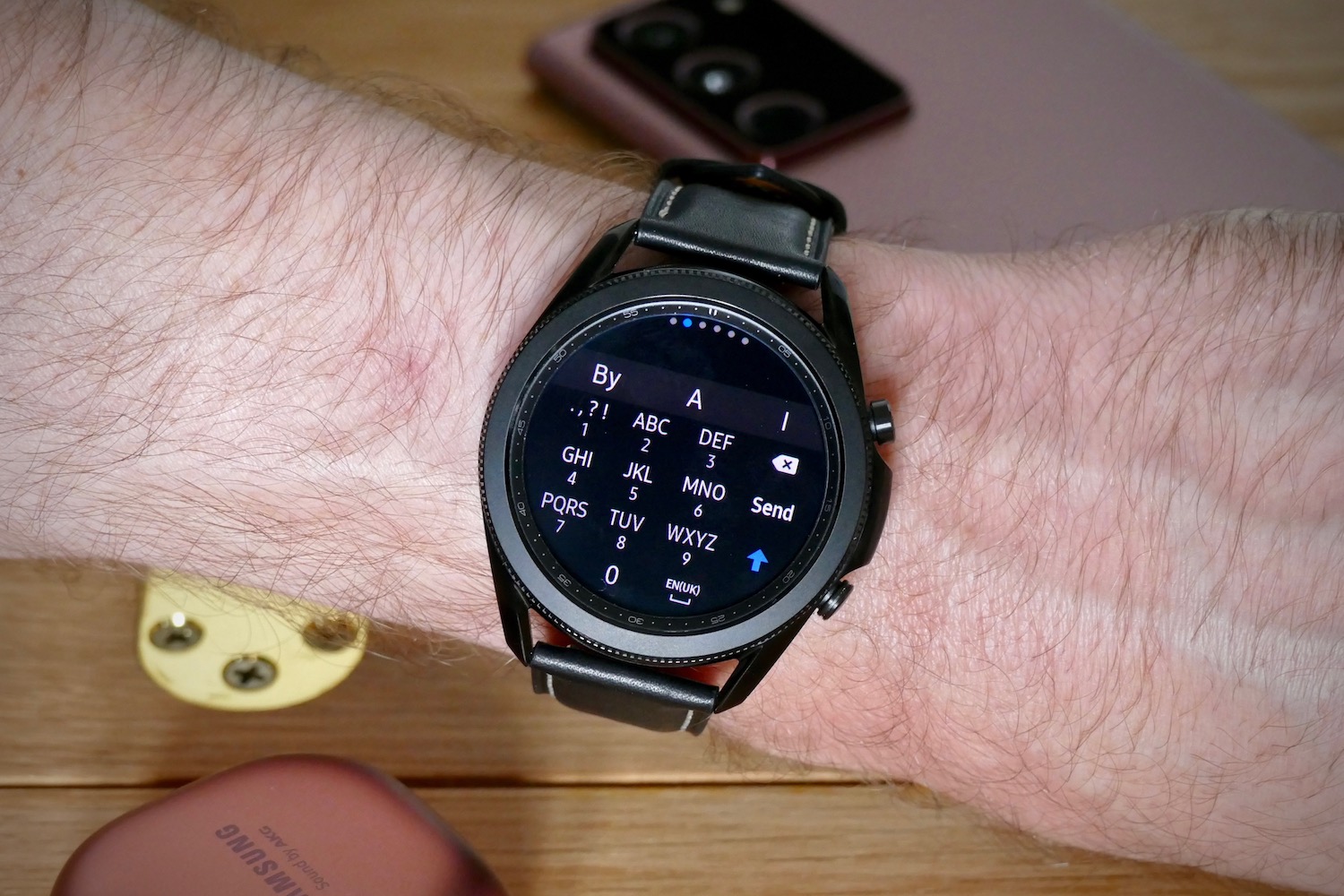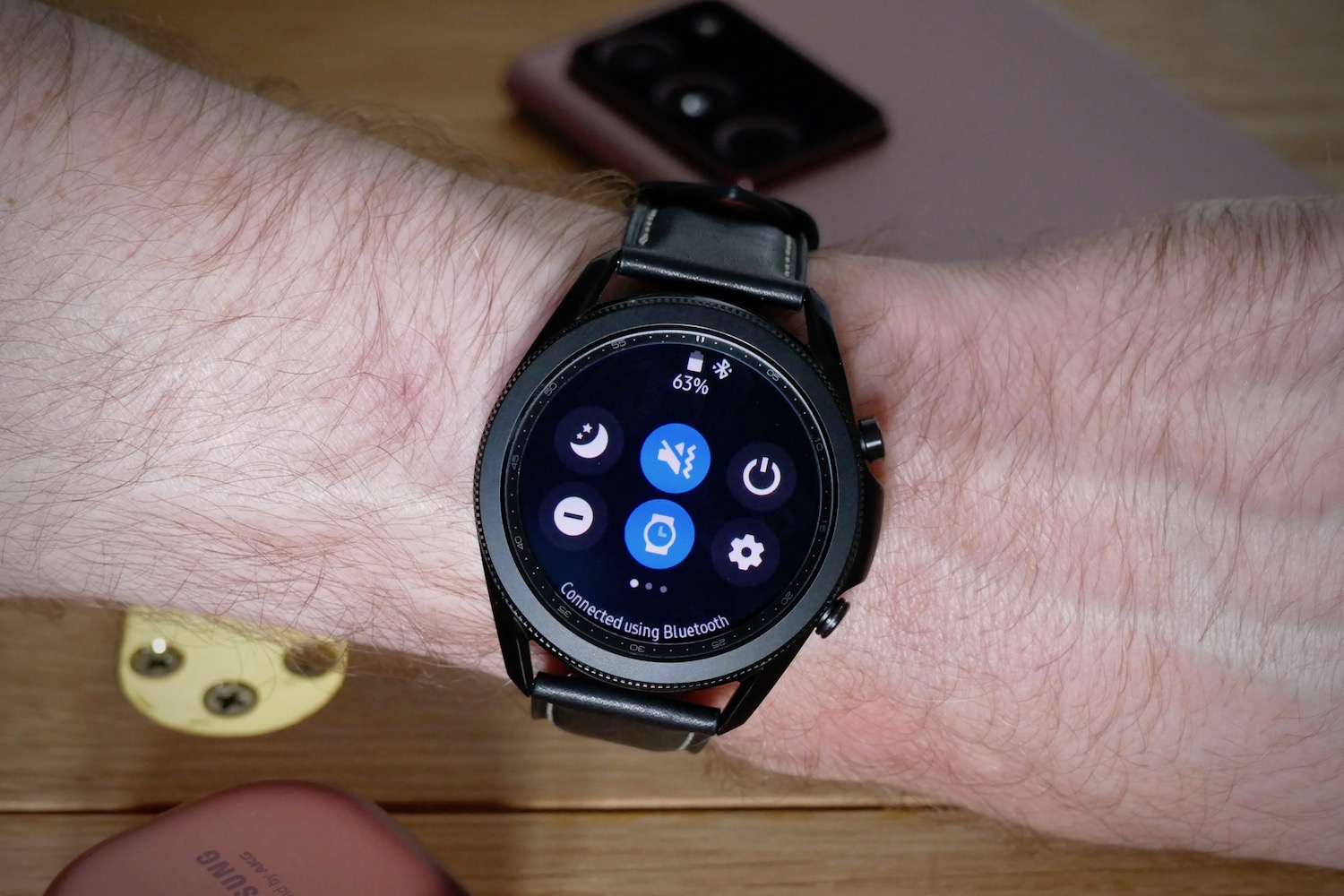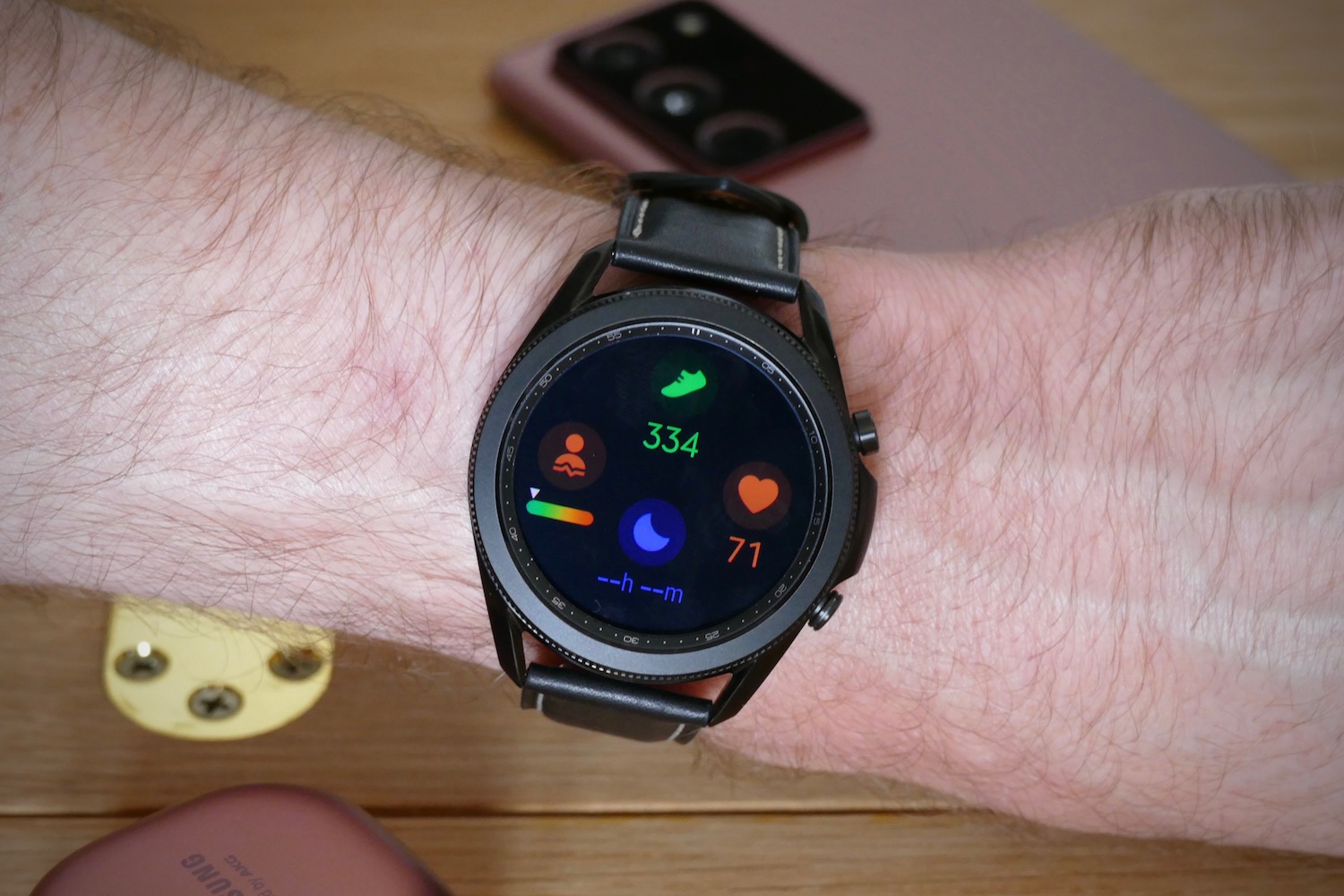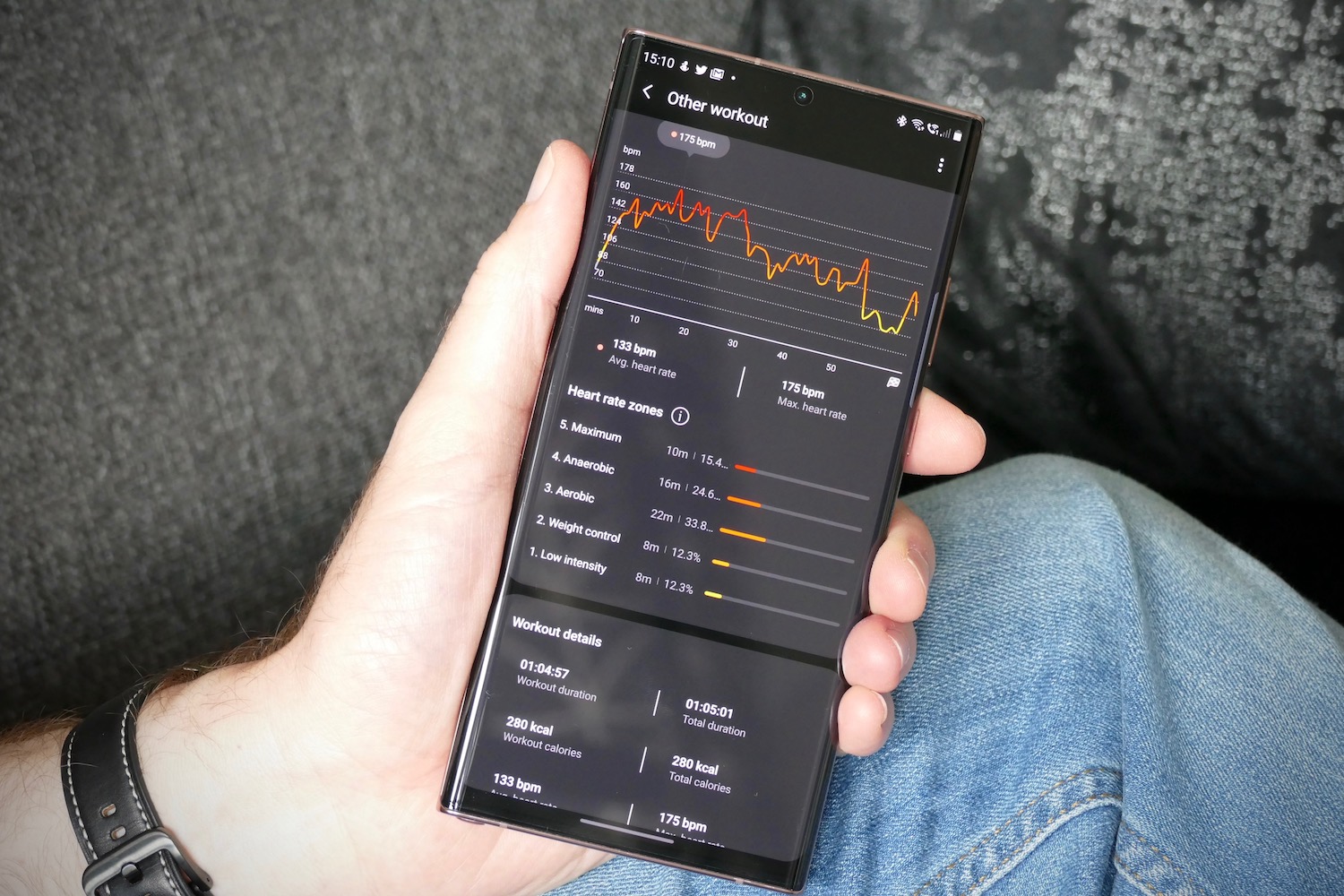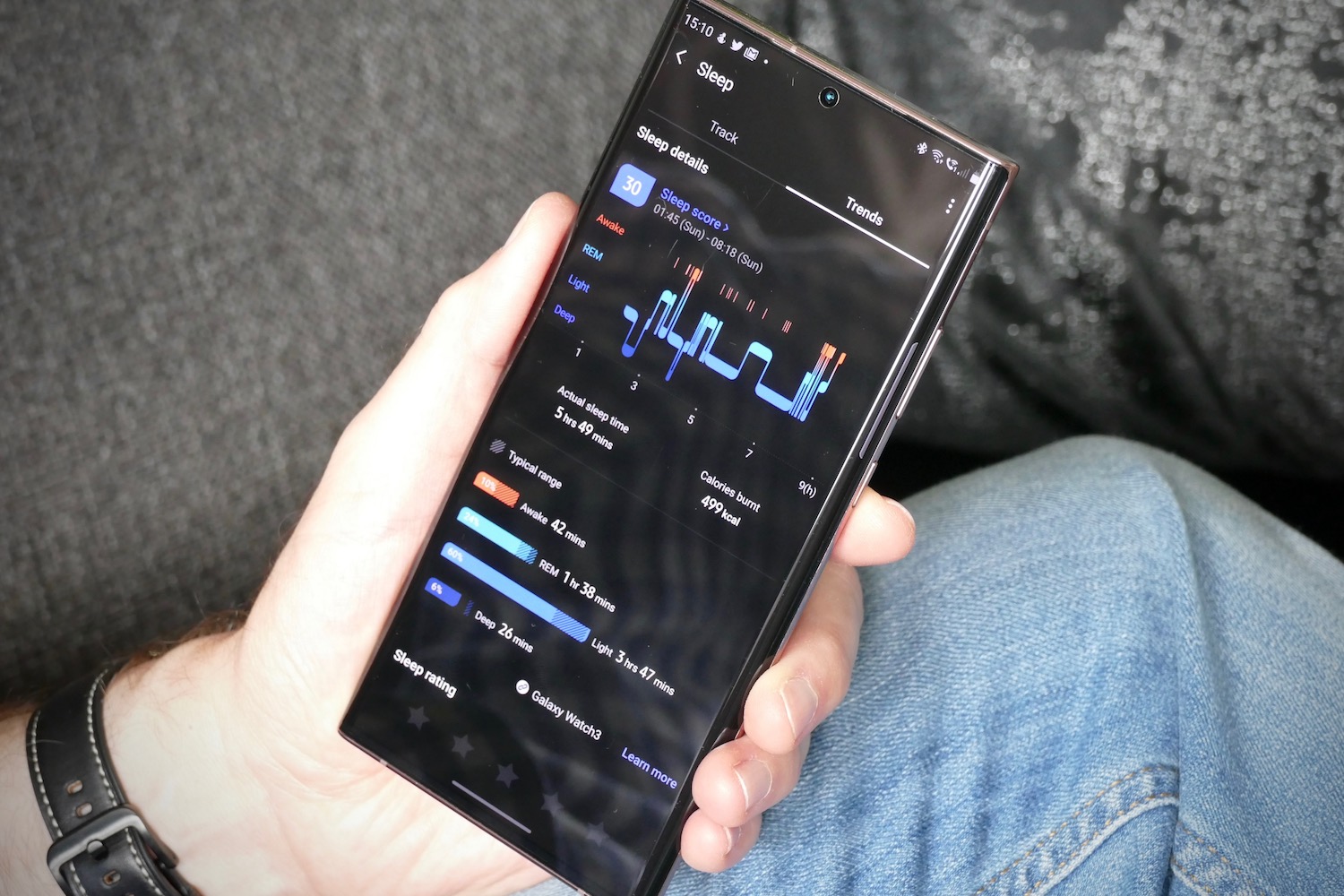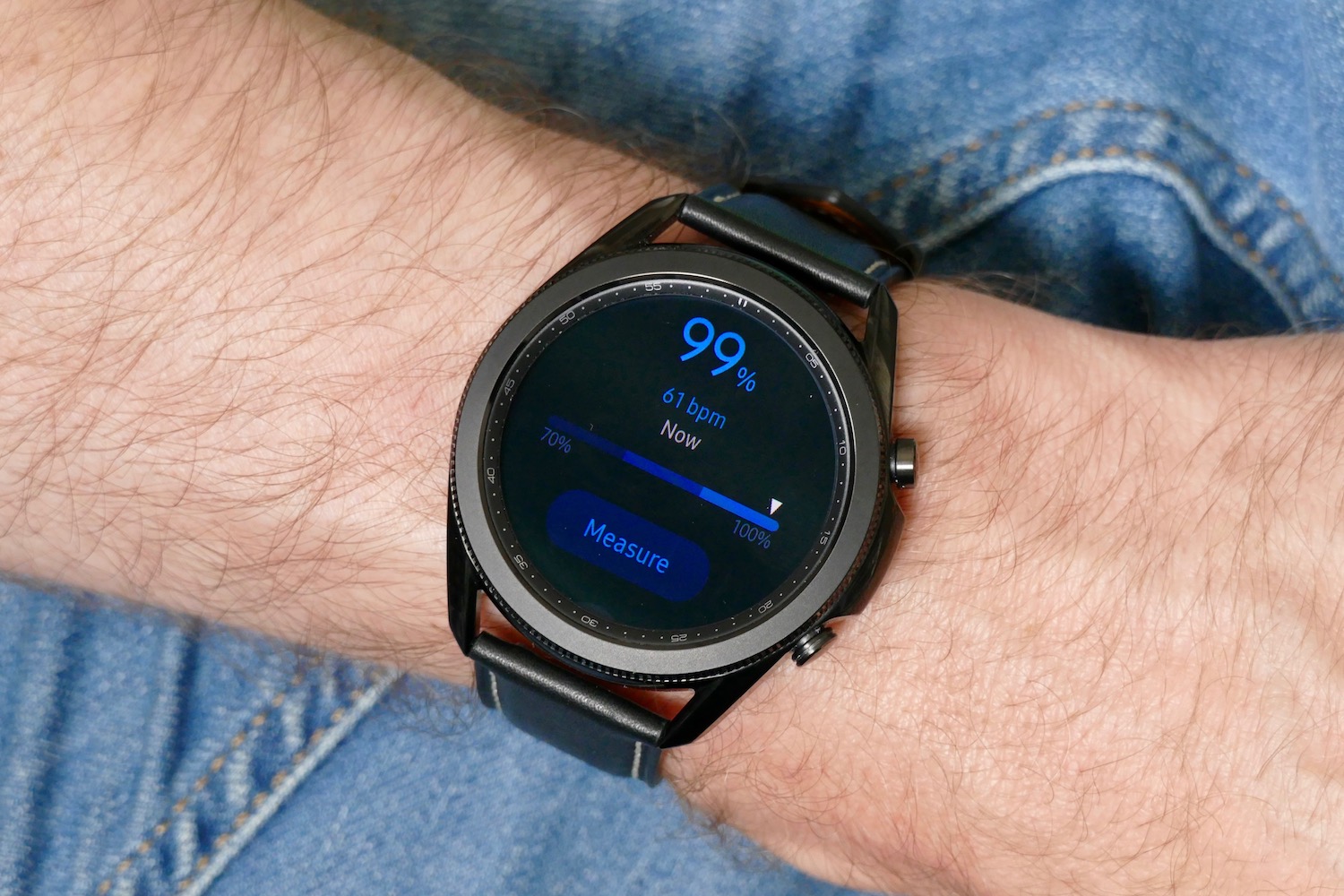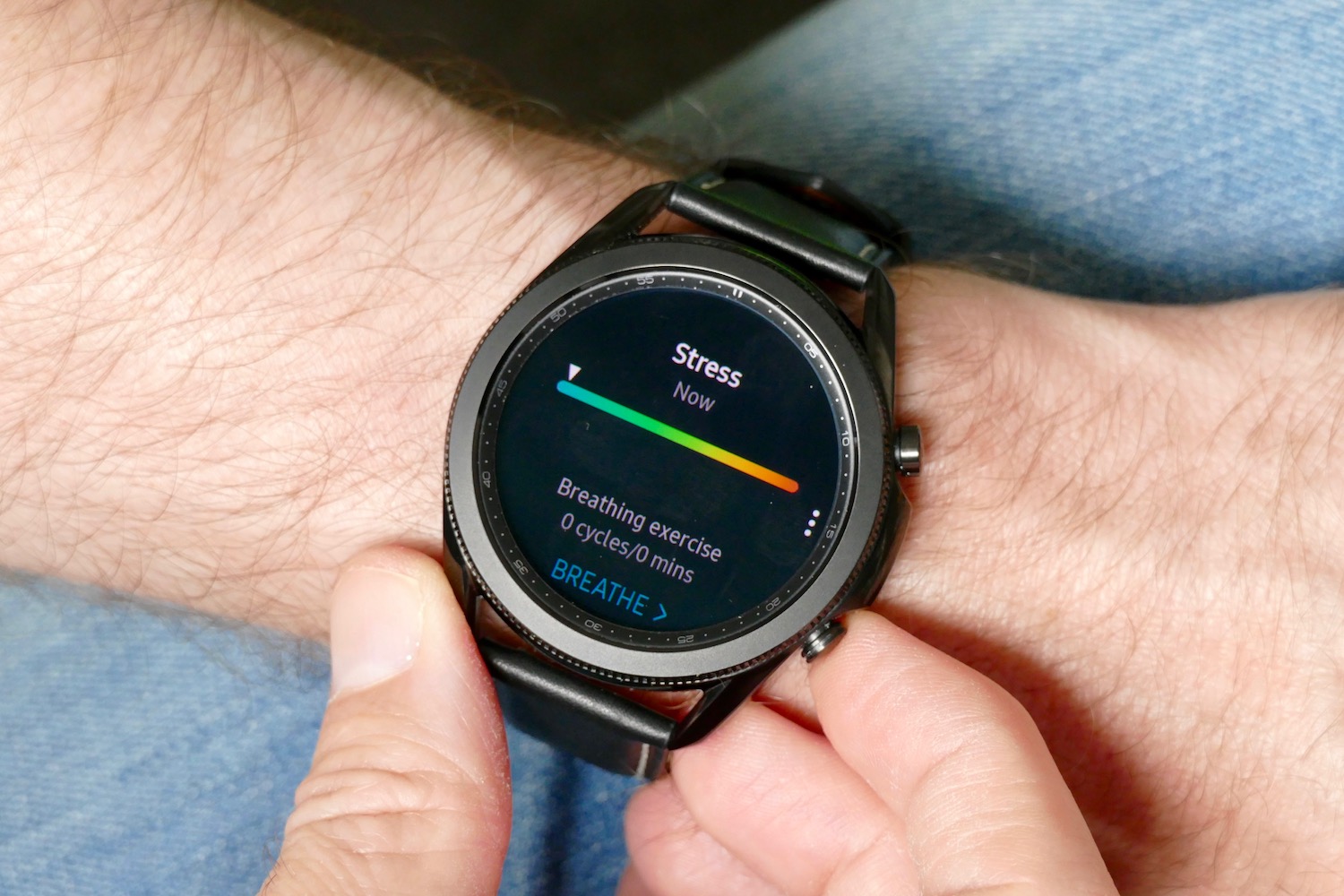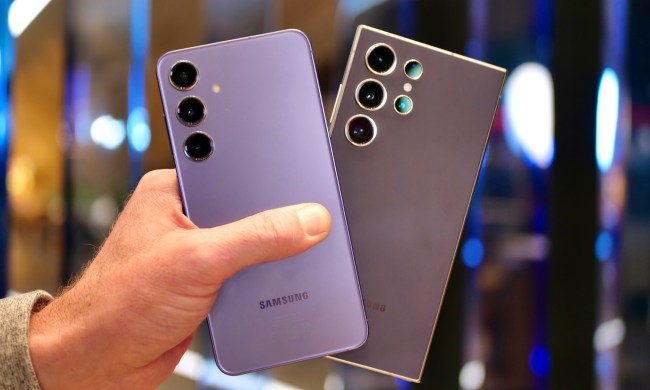- Stylish, traditional watch looks
- Attractive, reliable software
- Brilliant rotating bezel aces the control system
- Comprehensive health-tracking features
- Solid battery life
- Questionable fitness-tracking accuracy
- Slow battery charging
If you own an Android phone, which smartwatch should you buy? The answer isn’t as obvious as you might think. You can’t use the shoe-in choice, the iOS-powered Apple Watch, which is unchallenged at the top of our smartwatch recommendation list.
Samsung hopes the new Galaxy Watch 3 can fill the role. After all, it shares many of the attractive aspects of the Apple Watch. It comes in two sizes, and has a good design, strong software, and a unique control system.
That makes it an easy recommendation for Android phone owners — with one caveat. You need to be happy to spend a pretty big sum to get one, foibles and all.
Design

I’ve been wearing the 45mm Galaxy Watch 3, which has a chronograph style and is slightly more masculine than the 41mm model. It also has softer design features for a less overtly sporty look. It weighs 53 grams (0.12 pounds) and is 11mm (0.43 inches) thick. Initially, its overall size made me lean toward the 41mm version as my preferred model, but the larger of the two has proven to be manageable, and settled down into being a comfortable companion.
The Galaxy Watch 3’s roundness makes it less obvious that you’re wearing a smartwatch, and I really like it for that. The 1.4-inch Super AMOLED screen has a 360 x 360 pixel resolution and is sharp and very colorful. You can select an always-on screen, which — unlike most WearOS watches — doesn’t minimize the watch face much. It dims the brightness and takes away any animations like a second hand, but the overall design stays onscreen. This helps it look like a regular watch.
The watch’s party piece is the bezel, as it physically rotates to move through the software.
Made from stainless steel, the Galaxy Watch 3 has Gorilla Glass DX over the screen and what looks like a glass case back too. Two buttons are separated by a guard piece on the right of the case, with the top one for backing up a step in the menu, and the lower for the app menu. A long press of the top button activates Samsung Pay, and a long press of the lower button summons the Bixby voice assistant. Take a close look at the top button, and you’ll see the words Galaxy Watch engraved on it, which is a really nice touch.

The watch’s party piece is the bezel, as it physically rotates to move through the software, rather than having to swipe on the screen or fiddle with a rotating crown.
Not only is this convenient and intuitive, it doesn’t obstruct the view of the screen when interacting with the software either. I really like the neatly dampened rotational movement and the soft clicks as it shifts into place. The response from the software is also hyper-fast, so you can spin it this way and that without the watch getting bogged down. In reality, you’ll want to use it with care and precision, which illustrates just how high-quality the action feels. Not touching the screen means fewer greasy prints on it, a lovely bonus, and the bezel’s subtle texture makes turning it natural.
My review model has a black leather, white-stitched strap thgat softened up soon after putting it on, and it’s attached to the case with 22mm quick release pins. Swapping to almost any other strap will be easy, but the Galaxy Watch doesn’t have the same level of third-party support as the Apple Watch does, meaning you’ll have to go through traditional watch accessory companies. That’s not a problem, but not as newcomer-friendly as the process of buying purpose-made Apple Watch straps.

Like all round smartwatches, the Galaxy Watch 3 sticks closely to a traditional watch design, so you may not be instantly spotted as a “smartwatch wearer” if you don’t want to be. But with that comes a degree of anonymity.
The Galaxy Watch 3’s uniqueness comes from its usability more than its looks. I appreciate its presence on my wrist, but Samsung hasn’t quite found a way to make my heart race by looking at it.
Software

Samsung uses its own Tizen software on the Galaxy Watch 3, and not Google’s WearOS seen on Fossil, Mobvoi, or Motorola’s smartwatches. Although WearOS is better than it was, it can be frustrating to use. Tizen on the Galaxy Watch is refined and mature, and is considerably closer in usability to WatchOS than it is to WearOS, but it still has some foibles of its own, including forcing a shift away from Google apps entirely.
First, the good stuff. I’m going to keep going on about it, but the rotating bezel is a work of genius. It’s simple and cleverly implemented and the key to the Galaxy Watch 3’s livability. Rotate to the left to see your notifications, rotate to the right to see fitness data, workouts, weather, quick-access buttons, and more. These widgets are easily customized so they remain relevant to you.
To its detriment, the Galaxy Watch 3 uses Bixby for voice control and not Google Assistant.
Samsung does a great job presenting data on the Watch 3’s small screen. Text is clear, large, and legible even in sunlight, and because the widget array can be personalized, you rarely need to visit the main app menu. This makes it fast to find what you want. It’s all very pretty, too, with plenty of images and graphics used throughout, right down to big profile pictures used with WhatsApp messages, and bold colors to differentiate modes, icons, and menu options. It’s fun and friendly without being cheap and off-putting. I like the choice of watch faces, as there are hundreds available in the Galaxy Store if you don’t like the pre-installed Samsung ones.
Haptics are strong and noticeable, but you need to raise your wrist markedly for the notification to show on screen, which can be annoying. Notifications can be interacted with using canned replies or emoji, voice, or a little alphanumeric keyboard. The keyboard is a little fiddly, but voice control is surprisingly accurate when dictating replies.
To its detriment, the Galaxy Watch 3 uses Bixby for voice control and not Google Assistant. Bixby doesn’t do things in a hurry, and even the command “hey, Bixby” means a several-second pause while it decides whether to listen or not. This makes it mostly useless, and nowhere near as good as Google Assistant on a wearable.
The lack of Google apps is a pain, with Google Maps being the one you’ll miss most. I find Maps on my wrist helpful in areas I don’t know, as I don’t have to stare at my phone like a tourist, but there’s no map option preinstalled on the Galaxy Watch 3 at all. The decent Here Maps app is available in the Galaxy Store, but Google Maps is not. Samsung pushes you into its own ecosystem with the Galaxy Watch. For example, you use Samsung Health instead of Google Fit, and Samsung Pay instead of Google Pay.

I have used the Galaxy Watch 3 connected to the Samsung Galaxy Note 20 Ultra phone, and it has worked without a problem. Setup is easy and fast, it connects and reconnects without issue, even when you turn the watch off overnight, and it even gives a little haptic reminder if you go out of range of your phone. If you use another Android phone or an iPhone, you will need to install Samsung’s Galaxy Wear app to use the watch.
The big thing for me is that Tizen on the Galaxy Watch 3 hasn’t been annoying, which WearOS almost always is. After getting the notifications sorted out during setup, it just sits back, gets on with its job, and isn’t irritating when I need to interact with it. This is part of the Apple Watch’s success, and it’s great to see it replicated for Android phone owners.
Health and fitness

The Galaxy Watch 3 has all the usual fitness-monitoring tools on board, plus a heart rate monitor, sleep tracking, auto fall detection, VO2 Max data, and blood oxygen monitoring. Like the rest of the software information, it is displayed in a colorful, easy-to-read way. It has sensible reminders to move about, and even little stretch routines that are easy and fun to follow — or to silence if you don’t have time.
The auto workout tracking is a bit overzealous, though. It kicked in when I was vacuuming, as well as when I was painting a door. The Galaxy Watch 3 now tracks sleep if you wear it overnight too. The results differed from my Withings Sleep Analyzer, — where the Withings tracked deep sleep, the Watch 3 seemed to classify it as light sleep instead.
The Galaxy Watch 3 covers everything I want from a fitness tracker, but there are some concerns over accuracy.
It’s not particularly informative outside of the basics, and because I personally don’t find wearing a watch while I sleep very comfortable, the data didn’t inspire me to wear it often. It does not measure heart rate during the night, so battery life is not badly affected. It drained about 6% during seven hours of rest, which does mean the watch struggles to make it through a second day of heavy use without a top-up.
Data syncs with the Samsung Health app on your phone, where you can also add food intake and water intake alongside basic information like step count, calories burned, and exercise data. There’s also a stress measurement tool linked to a breathing exercise program. The app is informative and attractive, complete with some basic explainers about why you may want to track features like stress.
The Galaxy Watch 3 covers everything I want from an everyday fitness tracker, but there are some concerns over accuracy. I noticed several data points seemed rather low compared to what I usually see, so I wore it alongside the Apple Watch for comparison. During a fixed period of time, there was a large disparity in steps taken, with the Apple Watch recording 940 and the Galaxy Watch 3 only 380 over an hour of comparison.
Wearing them both for a simple workout session revealed a massive difference in calories burned readings, too. The Galaxy Watch estimated 283 calories for a 64-minute session, which seemed low for an average heart rate of 133 bpm (beats per minute). The Apple Watch returned an average heart rate of 127 bpm for the same session and an active calorie burn of 471. Resting heart rates were identical, though.

While neither may be absolutely correct, the Apple Watch’s results have always been consistent with other wearables I review. Cause for concern? It’s not a medical device, so not really. Also, I’m using a prerelease Galaxy Watch 3, so a software update may arrive prior to launch to fine-tune its data-collection algorithms.
If you want the Galaxy Watch 3 for the ECG or blood pressure monitoring, these features are not available yet unfortunately. Both require approval by local governments before launch, and although the Food and Drug Administration has now approved the Galaxy Watch 3’s ECG feature, it has not been activated on my review model yet.
Battery

With moderate use. the Galaxy Watch 3’s battery will last two working days if it’s turned off overnight with the always-on display active. Introduce GPS, the continuous heart rate and stress level tracking, plus additional fitness tracking, and this will drop to little more than a single day. Tracking my sleep saw the battery drop from 48% when I went to bed to 42% in the morning.
I find the Galaxy Watch 3’s battery life acceptable, but certainly not desirable. It improves on many WearOS watches, which often can’t make two full days even with light use, but charging is very slow. The magnetic puck sticks fairly loosely to the back of the Watch 3, and regardless of which charging block I used, the charge time from 5% to 100% was at least two hours and 15 minutes.
I wore the Galaxy Watch 3 alongside the Apple Watch for a couple of days to compare the battery usage. Between 9 a.m. and 6 p.m., the Galaxy Watch 3’s battery went down to 66%, while the Apple Watch’s dropped battery to 75%. I turned the watches off at midnight and on again at 9 a.m., then tracked a one-hour workout and continued using then all day. The Galaxy Watch 3 showed 5% at 10 p.m., while the Apple Watch had 10%. When it hit 15% and 5%, the Galaxy Watch 3 suggested turning on a battery-saver mode, where only the time would be shown, to extend its use.
Using the Galaxy Watch 3 with other Android phones and the iPhone
The Galaxy Wearable app required for the Galaxy Watch 3 to connect with your phone is available in Google Play and the iOS App Store. I’ve been testing it with a Samsung phone, but what’s the experience like using it with a different manufacturer’s device? I’ll be updating this over the course of the next weeks as I use the Watch 3 with different phones. I will uodate this story with the results
Price and availability
The Galaxy Watch 3 costs $399 for the 41mm Wi-Fi model or $429 for the 45mm Wi-Fi model. Samsung also makes a 41mm 4G LTE version that costs $449, and a 45mm 4G LTE version for $479. Both are compatible with all major U.S. carriers. All Wi-Fi models will be released on August 20, with the 4G models coming in September.
In the U.K. the 41mm Wi-Fi model is 399 British pounds and the 45mm Wi-Fi watch is 419 pounds. The 4G LTE devices cost 439 pounds for the 41mm model and 459 pounds for the 45mm model.
Since we’re talking about smartwatches, our best move would be to provide you with all Black Friday smartwatch deals, so that you can leverage the Black Friday discounts.
Our take
The Samsung Galaxy Watch 3 isn’t perfect, but it’s the best smartwatch you can buy if you own an Android phone. The software is reliable and pretty to look at, the control system is an absolute winner, there is a choice for small and large wrists, and it has comprehensive health features too.
You pay a high price, though. It’s double what you’d spend on some WearOS watches, and because smartwatches remain a nice add-on rather than an essential, you’ll really have to be sold on the concept to spend so much. However, the Galaxy Watch 3 is the only modern smartwatch aside from the Apple Watch that I’ve felt happy to continue wearing even when the review period is over. I think that’s a strong recommendation.
Is there a better alternative?
The biggest rival to the Galaxy Watch 3 is the Galaxy Watch Active 2. It’s cheaper and has the same software, but a touch-based version of the rotating bezel and a less interesting design. It’s a great buy if you don’t have the budget for the Galaxy Watch 3. If you want WearOS for Google’s apps, then the Fossil Gen 5 is good, and so is the Moto 360. Cheaper still is the Mobvoi TicWatch C2 Plus. Just remember WearOS is not as polished or as easy to live with as Tizen.
If you own an iPhone, there’s nothing here that should be tempting you away from the Apple Watch yet. Even if the experience is good, only the Apple Watch integrates with Apple’s messaging system and apps, meaning you should still buy the Apple Watch if you own an iPhone.
How long will it last?
The Galaxy Watch 3 has an IP68 water- and dust-resistance rating, plus MIL-STD-810G toughness, which means it should be fine for use everyday and in most situations. The design shouldn’t age badly, and provided Samsung continues to support the app, the Galaxy Watch 3 will last as long as you own your current phone without a problem.
Should you buy it?
Yes. It’s expensive, but if you’re connecting to an Android phone, it’s worth it.


